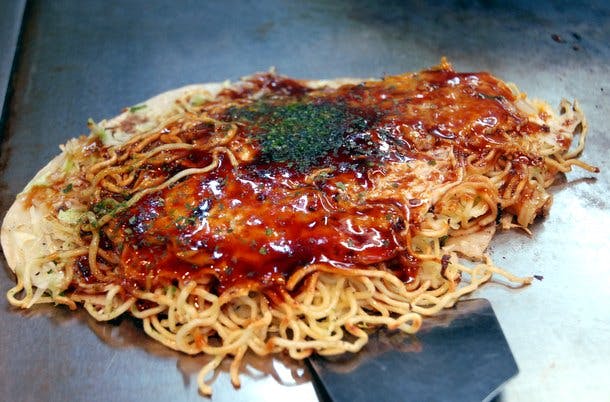
"your choice," fuchu style
Discover the savory taste of Fuchu-style okonomiyaki, a traditional Japanese dish with your choice of toppings. Visit Furokawa Shokudo, a charming restaurant in a small country town near Hiroshima, and savor the unique flavors of this beloved dish, prepared by experienced cook Miyoko-san.
I was in small country town called Fuchu, a couple of hours outside of Hiroshima, and getting hungry. I spent the morning visiting the area's remaining traditional "miso brewers" (I'm writing a post about this shortly!), and one of them, a Mr. Kanemitsu, invited me to lunch. "We make a special Fuchu-style okonomiyaki here," he said. Want to try?"
According to my handy Dictionary of Japanese Food (by Richard Hoskins, an indispensible book), okonomiyaki literally means "your choice" -- as in your choice of toppings on a savory pancake that looks like an oversize crepe. Osaka and Hiroshima claim their own celebrated versions of this dish. Fuchu, it seems, does too.
Mr. Kanemitsu led me through the old town's winding, narrow streets. "A maze," he said with a laugh. We came upon a white, two-story home and entered the ground floor. It was a restaurant called, simply, Furokawa Shokudo - Furukawa food shop. The brightly lit place had a satisfying aroma that reminded me of pancakes and bacon. A soap opera played on a TV in the corner with the volume turned low. Eight customers sat on chairs that lined an L-shaped flat steel teppan, a table-sized griddle three feet across and sizzling. On the other side stood a small, elderly woman wearing a kitchen smock over a lavender sweater. I learned that her name was Miyoko-san and she's been preparing okonomiyaki for over fifty years.
The menu lists sixteen kinds of okonomiyaki. I asked for the house special. Miyoko-san set to work. She ladled a white batter that looked like pancake batter, spreading into a crepe-thin 12 inch-wide circle. On top she liberally sprinkled pepper and tempura crumbs, and layered in turn a tall clump of shredded cabbage, two packs of fresh soba noodles and handfuls of raw shrimp and shredded pork belly ("In Hiroshima they use sliced pork, but we like ours shredded," she explained). She poured a little more batter over the pile and waited, watching. A few moments later, gripping steel spatulas in both hands, she deftly flipped this Himalaya of a pancake. Nary a soba noodle out of place. "It takes a long time to learn how to flip correctly," she said, proudly. Miyoko-san cracked an egg on the griddle, spread it thin, eased the now-steaming mountain over it and flipped it again a few seconds later. She topped the okonomiyaki with "Carp Sauce" -- a brand of oyster sauce named after the Hiroshima Carps baseball team, the local favorite -- sprinkled powered nori seaweed in the center and slid it over to me. Ready.
My okonomiyaki rested on the hot griddle before me. I cut it with a miniature spatula and shoveled bites into my mouth with said implement. It was delicious: The tangy Carp Sauce added zing to the crispy pancake and savory middle. Behind me, families sat on around a couple of tables, father, mother, kids and a grandparent or two. I could hear the kids laughing and singing with delight as they ate their okonomiyaki. It occurred to me that this was a Monday afternoon, a workday, yet entire families had time to meet and lunch together. A pleasure of small town life.
